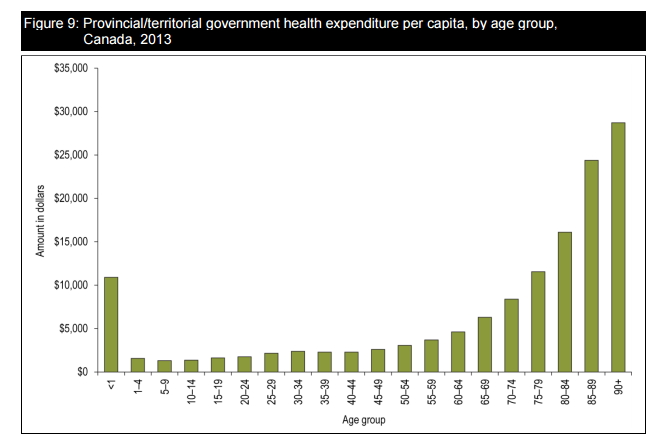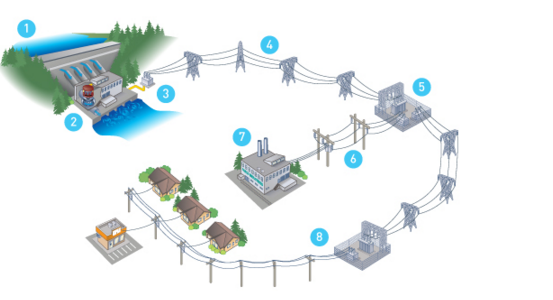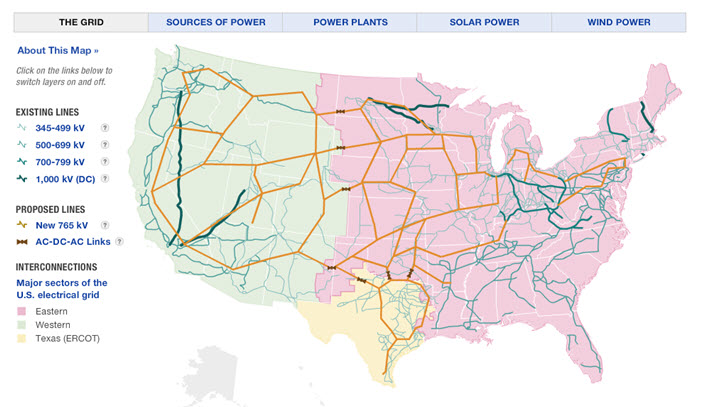
What to do… What to do? When it comes to the elder care time bomb, we know the cost of caring for the elderly; the graph accelerates sharply as we approach the end. The chart below is for Canada. The scenario is common around a good chunk of the ‘Western’ world. These scenarios are unsustainable.

Source: Canadian Institute for Health Information – National Health Care Expenditure Trends (1976-2015) Report
Addressing the elephant-in-the-room challenge
What to do? Just about every city, region, country that is dealing with this problem, is advocating for more home-based care, as a prudent response. Aging-in-place, closer to home… enabling people to live out the end of their lives, at home, outside of cost-intensive care facilities, makes sense, in more than economic ways.
The catch is that our societies, at least the one I find myself, aren’t really set up for aging-in-place. Effective aging-in-place requires care that goes beyond family. It goes beyond government handouts. Writ large, it requires a cohesive, community, systems approach.
Unfortunately, we haven’t truly committed to the elephant-in-the-room challenge – to build a ‘caring’ society. Why? Because, a caring society requires us to reconcile our individualistic culture with our collective needs.
Reconciling differences – sounds like the work of a mediator!
The Care Grid Vision
One of the most inspirational books I read in 2015 was Ai-Jen Poo’s The Age of Dignity: Preparing for the elder boom in a changing America. MacArthur Genius Award Winner Poo (@aijenpoo) advocates for the building of a Care Grid:
“An infrastructure for care may seem different from an infrastructure for railroads, highways, electricity, or the Internet. There are no trees to clear or wires to lay. Yet, care is among the fundamental building blocks of society. For any of us, thinking of our most basic needs – care always comes first. There no need for the Internet or even electricity, if there’s no way to feed, bathe, or clothe yourself.”
A Care Grid, akin to the railways or electricity grids? Yes, we can. The Care Grid is the responsibility of all of us:
“Since care is a need that shared across American families, it should be a responsibility that’s shared by all of us as a nation. We brought water, electricity, and the Internet to every home. We can bring quality care to every home. But the Care Grid is a system we’re going to have to invest in and create together. When we build the infrastructure we need to support human life so much will be released I positive, transformative ways, in our families, community, and economy. Rather than each of us struggling though in lonely isolation, we will have a shared base of support and structure on which to build our individual lives. As the elder boom arrives, we must take up the building of a Care Grid. We’ve done it before, and we can do it again.”
The vision goes further:
“Care work is such a significant part of the workforce of the future that it can become a model for the rest of the economy, with tremendous ripple effects. It can be a place where we attempt to leverage technology and innovation to pave a road from low-wage, high-burnout work to good job with benefits and security. It can offer the context for discussing both the new freedoms that a freelance economy offers, and a new framework for security for the twenty-first century that accounts for the needs of working people universally, such as paid sick days, child care, health care, and home care. If we fail to do so, we will continue to accelerate the expansion of unsustainable, poverty-wage care work and, in turn, undermine our ability to provide quality care for the millions who are counting on it.“
With a personal stake in family caregivers and immigrants, and a background in information technology and conflict management, the Care Grid concept captured my imagination. Finally, I’m getting around to making visible some of my own thoughts. (one of the values of a blog)
Understanding How the Electricity Grid works
If the Care Grid is to be another type of grid, its’ helpful to understand how existing grids work. By example, let’s look at the Electricity Grid. (Hang in there – I try (ha!) keep it simple.)
Every single piece of matter in this world, from rocks, to plants, to animals, to people, is made up of atoms. Every atom contains one or more electrons. When we humans figured out how to control the movement of those electrons: electricity. We learned how to create infrastructure to generate, transform, transmit, and distribute, the power of nature, to businesses and homes, en masse, in reliable and safe ways.
In my province, British Columbia, over 90% of electricity is generated via hydroelectric dams. Here’s what that system; generation, transmission, distribution, looks like:
Source: BC Hydro Electric Generation System (overview)
The abbreviated version of the electricity journey (above):
1.Water is dammed behind a big wall.
2.Water is released from the dam. It flows down, with force. It turns the turbines. The turbines connect to generators. The generator changes mechanical power into electric power.
3.The electric power is transformed, “stepped-up”, for distance travel.
4.Transmission lines send the electricity on its way.
5-6-7.Transmission to big consumer. (e.g., manufacturing plants that need a whack of energy in order to operate).
8. At a distribution substation, the electricity is “stepped-down”, made safe, and distributed to your home.
Hello: toaster!
It doesn’t stop there, though. These electricity networks (such as BC Hydro) are connected together, in grids. In the United States, there are 3 major grids; Eastern, Western and Texas (go figure!). The schematic below is from NPR’s Visualizing the U.S. Electric Grid:
Visualizing a Care Grid based on an Electricity Grid
With a very rudimentary understanding of how the Electric Grid works, here is how I relate that understanding to a Care Grid. I’ll wear any ridiculous jumps of logic, in the comparison).
| Grid Feature | Electricity Grid application | Care Grid application |
| Purposeful | Connect electricity producers to consumers. Ubiquitous access to electricity. | Connect caregivers to care recipients. Quality care to every home. |
| Relationships | A consumer trusts the producer; to supply their electricity needs, on-demand. | A care recipient trusts the caregiver to understand and support their needs. Conversely; a new caregiver every day is not a relationship most (any?) care recipient desires. |
| Dynamic System | Grid stability requires continuous electricity production & usage, as electrical power can’t be stored effectively. | Quality care involves full attention; being “present”, in the moment. |
| Transformative | Transformers step-up (increase) voltage (electric potential; pressure) so the electric current can be efficiently transmitted long distances. | Education, training and support increase caregiver capacity; to deliver appropriate care. |
| Transmission | Some electric current is lost in the transmission process. | Long distance care works. Virtual care is built on virtual communication best practices. |
| Distribution | From a single power source – many different types of consumers can be served through an effective distribution network. Resource/cost allocation is fair. | Closer-to-home is the most cost effective distribution model; for care services, and supporting caregivers. Unpaid caregivers are made visible, compensated, not alone. |
| Safety | Transformers step-down (decrease) electric voltage so that electricity is safe to use. | Caregiver interactions with caregivers are appropriate, and demonstrate concern and respect. As a result, care recipients feel safe and supported. |
| Interconnected and coordinated | Interconnected grids; producers and consumers. Coordination; so not oversupply in some areas, and not enough in others. | Care services are required everywhere; at-home, in a facility, across the country (remote caregiver). Organizational silos to care delivery are minimized; e.g., via community-based management solutions. |
| Continuum of service | Each consumer has their own unique needs, and service requirements. There is a continuum of power generation-purchase options. | There is a continuum of care service options, appropriate to each environment; at-home, workplace, community facility… |
| Standards | Mandatory reliability standards for planning and operating the power grid. | Fair workplace standards are in-place; attentive to both paid and unpaid caregivers, and the recipients of their care. |
| Natural laws | All that any machine (e.g., turbine/generator) can do is change one kind of power to another; e.g., mechanical to electric power. It can never make power where there was none before. | Caring is the most important part of care. All other skills can be learned. |
Now What?
Well – I’m thinking highways grid, internet… Lots of x-industry learnings are ahead. Not to mention some ‘reality checking’.
From your perspective, what existing grid could a Care Grid most learn from?
———————–
(Grid image credit: #14951669 on 123RF.com)



Speak Your Mind